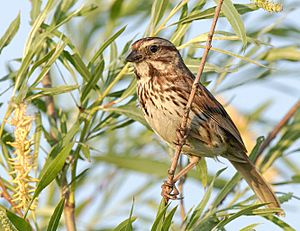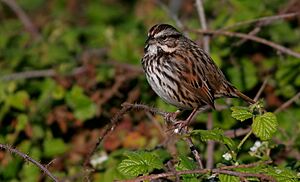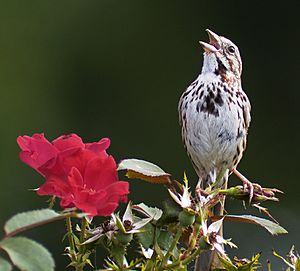Song sparrow facts for kids
The song sparrow (Melospiza melodia) is a common bird found across North America. It's a medium-sized sparrow and one of the most widespread and adaptable birds in its family.
Quick facts for kids Song sparrow |
|
|---|---|
 |
|
| in Whitby, Ontario, Canada | |
| Conservation status | |
| Scientific classification | |
| Genus: |
Melospiza
|
| Species: |
melodia
|
 |
|
| Part of the range of M. melodia Breeding range Year-round range Wintering range | |
| Synonyms | |
|
Melospiza cinerea |
|
Contents
What Does a Song Sparrow Look Like?

Adult song sparrows have brown feathers on their backs with dark streaks. Their undersides are white with dark streaks and a dark brown spot in the middle of their chest. They have a brown cap on their head and a long, rounded brown tail. Their face is gray with a brown stripe going through each eye.
These birds can vary in size depending on where they live. They are usually about 11 to 18 cm (4.3 to 7.1 in) long, and their wingspan can be 18 to 25.4 cm (7.1 to 10.0 in). They weigh between 11.9 to 53 g (0.42 to 1.87 oz). The average weight is about 32 g (1.1 oz). Song sparrows can live up to 11.3 years in the wild.
It's easy to mix up song sparrows with other birds like the Lincoln's sparrow or the Savannah sparrow. You can tell a Lincoln's sparrow by its shorter, grayer tail and different head pattern. Savannah sparrows have a forked tail and yellow spots on their face if you look closely.
Where Do Song Sparrows Live?
Song sparrows can live in many different places. They like brushy areas and marshes, including salty marshes near the coast. You can find them across most of Canada and the United States. They also do well in places where humans live, like suburbs, farms, and along roads.
Birds in the southern parts of their range stay there all year. However, song sparrows from northern areas fly south for the winter. They travel to the southern United States or Mexico. Sometimes, a few song sparrows even fly far across the ocean to western Europe, with some spotted in Great Britain and Norway.
These birds usually look for food on the ground, in bushes, or in very shallow water. They mostly eat insects and seeds. If they live in salt marshes, they might also eat small crabs or other tiny sea creatures.
Reproduction and Life Cycle
Song sparrows build their nests in hidden spots on the ground or in trees and bushes. If a song sparrow has bushes in its territory, especially away from the coast, it has a better chance of surviving the winter. It also has more success raising its young.
Female song sparrows lay three to five eggs at a time. The eggs are brown with greenish-white spots. They sit on the eggs for about 13 to 15 days until they hatch.
Scientists have studied song sparrows to learn how their bodies react to things like daylight and different weather. Birds often get ready to breed when the days get longer. However, for song sparrows, it seems that many things, not just daylight, affect when and how they breed.
The Song of the Sparrow

The song sparrow gets its name because it has so many different songs! People who love birds say that one of their songs sounds a lot like the beginning of Ludwig van Beethoven's Symphony No. 5. Male song sparrows sing complex songs to show other birds that an area is their territory. They also sing to attract female sparrows.
Their songs are a mix of repeated notes, quick single notes, and trills (a rapid back-and-forth between two notes). The songs are very clear and easy for humans to hear. Each song is unique because of its pitch, rhythm, and the sound of the trills.
A single song sparrow can know many different songs, sometimes up to 20 tunes with thousands of variations! Unlike some other birds, a song sparrow usually repeats the same song many times before switching to a new one.
Song sparrows learn their songs from other birds that live nearby. They are most likely to learn songs that their neighbors also sing. This helps them communicate with their neighbors. Female song sparrows can even tell the difference between their mate's songs and those of other birds.
Who Are Their Enemies?
Common predators of the song sparrow include cats, hawks, and owls. Snakes, dogs, and the American kestrel are also threats, but perhaps less so. Song sparrows learn to recognize enemies from both instinct and by watching other birds. They change their behavior based on their own experiences and what they see. For example, they seem to be born with a fear of owls and hawks, but they learn to fear cats.
Sometimes, a bird called the brown-headed cowbird will lay its eggs in a song sparrow's nest. This is called "nest parasitism." Cowbird eggs look a lot like song sparrow eggs, but they are a little bigger. Song sparrows see cowbirds as a danger and will attack them if they come near the nest. Some studies suggest that this behavior is learned, not instinctual.
Even though cowbirds can cause some song sparrow nests to fail, overall, cowbirds don't seem to harm song sparrow populations much. This is because song sparrows can raise many groups of chicks in a season. They are also good at raising cowbird chicks along with their own.
Different Types of Song Sparrows
The song sparrow has many different types, or subspecies, across North America. There have been 52 subspecies named, and 25 of them are still recognized today. These different types often look a bit different depending on where they live.
For example, the "Eastern group" of song sparrows are usually small, brownish, and have strong black streaks. The "Northwestern group" are larger and darker. The "Cismontane California group" are small, brownish, and have clear markings. The "Southwestern group" are small and pale with reddish streaks. And the "Mexican Plateau group" have black spots and white throats. These differences help them survive in their specific environments.
Conservation Status
Overall, the song sparrow is a very common and widespread bird. Because of this, the IUCN says it is a species of "Least Concern." This means it is not currently in danger of disappearing. However, some specific types of song sparrows in California are listed as "Species of Special Concern." This means they need extra attention to make sure their populations stay healthy.
Images for kids
-
Taken near Anacortes, Washington in March, this individual is most likely M. m. morphna
-
Taken at Springfield, Oregon in early April, this photo probably shows M. m. cleonensis or a "phaea" hybrid
See also
 In Spanish: Gorrión cantor para niños
In Spanish: Gorrión cantor para niños




